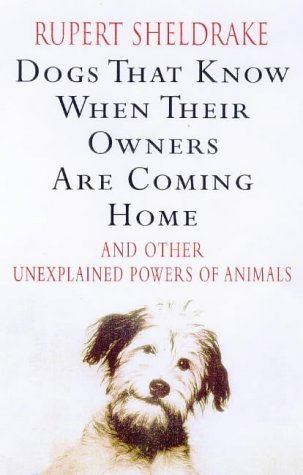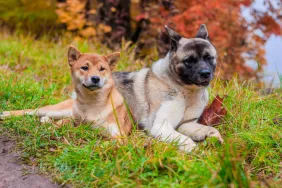by Michael Mountain
Founder, Best Friends Animal Society and The Stubby Dog Project
Pudgie hated thunderstorms. Well before the first clap of thunder was to be heard, my Sheltie was getting agitated and looking for his safe place in the closet. What was he sensing? Had he made a connection between the winds, the growing humidity, the drop in barometric pressure and perhaps some static in the air?
Or did he have a “sixth sense”?
According to a new poll from the Associated Press and Petside.com, two-thirds of Americans with pets say their companions do indeed have some unknown way of sensing things that we don’t.
Most of these (64 percent) said their pets tried to hide in a safe place, half of them said they whined or cried or became hyperactive and erratic, and 36 percent said they barked or meowed persistently.
And pets don’t just pick up on bad weather. Forty-three percent say their dogs, cats, fish and other animals even know when other kinds of bad news are on their way.
One of the people who was polled, a New York publicist, said her Miniature Pinscher mix, Rocki, has a nose for predicting trouble. Last week, for example, she put a pot of water on the stove, then left the room. “After a while Rocki came in and barked at us until we followed her to the kitchen, where all the water had boiled down and the pot was burning,” she explained.
Rocki certainly knew something was wrong. But was this an example of a sixth sense? Would dogs need anything more than their five senses to go on the alert when something’s burning?
Perhaps not. But there’s no question that animals are attuned to many things that escape the attention of us humans.
Dogs can anticipate seizures, and can detect certain forms of cancer, low blood sugar and other medical problems. These are all due to their remarkable sense of smell.
But sense of smell is probably not what alerts animals to earthquakes. And even if, with earthquakes, they’re sensing subtle changes in the earth and atmosphere, what about tsunamis, where the quake can be thousands of miles away? When the big tsunami hit South Asia in December, 2004, much of the wildlife near the coasts had already begun heading for the high ground long before the wave came ashore.
Is something deeper going on?
Cambridge University scientist Rupert Sheldrake has been studying phenomena like this for many years, and he has no doubt that there’s some kind of a sixth sense at work – and one that any of us can tap into, too.
“In the Alps, there is quite a lot of evidence that before avalanches, the mountain animals come down and get out of the way,” he said. “They seem to know when it’s going to happen. Obviously, in the course of evolution, animals that can get out of the way of disasters are going to survive better than those that don’t. So, there are very good reasons in natural selection for these abilities to develop.”
What is it that the animals are tapping into? Sheldrake thinks that with earthquakes, they could be detecting electrical changes. But that wouldn’t apply to tsunamis. And there are certain kinds of disasters that animals react to in advance, and that are not natural.
“During the Second World War,” said Sheldrake, “a lot of dogs and cats in England gave their owners warning of German air raids at least half an hour before the bombing began, when the planes would still have been 150 to 200 miles away. It couldn’t just have been hearing. The wind was often blowing in the wrong direction. The same happened in the recent American air raids in Baghdad. So, this suggests to me that there is an element of precognition involved.”
How we can reconnect with our sixth sense
So, if this is the case, is it a sense that we humans have lost, that we never had, that we’re crowding out because of all the stuff of daily life, or what?
“I think that these abilities are actually much better developed in so-called traditional people,” Sheldrake proposes. “There was a report about the Stone Age tribal people who live on the Andaman Islands. Originally, people felt they would have been destroyed by the tsunami. But it turned out they’d retreated to higher ground in the jungle before it struck, which might suggest that people in a traditional society were able to pick up something.”
Sheldrake has developed a theory that revolves around what he calls morphic fields. It proposes that all life and the earth may be connected on some very fundamental level.
“The theory suggests that each species has a kind of collective memory. And also that people who are bonded with other people or animals have a field that connects them, which is how they influence each other at a distance. I think that’s the basis of telepathy.”
But even telepathy doesn’t account for premonitions. “A premonition,” he explains, “depends on some influence from the future doesn’t really fit into my own theories – or indeed anyone else’s. We just don’t understand it. And yet, I think the evidence shows something like that is happening. The only way that we’ll find out what’s going on is by studying it and by paying attention to the evidence. We certainly won’t learn anything by pretending this doesn’t happen and just trying to dismiss the whole thing.”
One of Sheldrake’s books, Dogs Know When Their Owners Are Coming Home, describes a series of tests that compared the reactions of dogs at home to when their guardians left work or some other appointment – and at random times – and started heading for home. The methodology has been criticized by some more traditional scientists, but, at very least, there’s a lot of food for thought in it.
This article first appearedhere on zoenature.org.
Michael Mountain is one of the founders of Best Friends Animal Society, the nation’s largest animal sanctuary and one of the pioneers of the no-kill movement for homeless pets. As president of Best Friends and editor of Best Friends magazine, he helped to build grassroots adoption and spay/neuter programs all over the country before stepping down in 2008. He currently is the editor and co-founder of Zoe— a new online magazine for people who care about animals, nature and the environment — and the co-founder of StubbyDog, which is working to change public perceptions of Pit Bulls.









